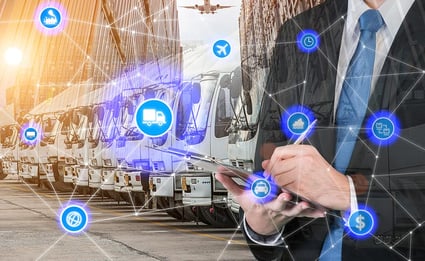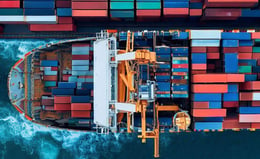The Top Sustainable Supply Chain Risks You Never Hear About
Keith LaBotz - April 07, 2022

Sustainability is an attractive idea worth pursuing, but we’re heading into uncharted waters. That’s why you need to know about its downside risks.
What downside? If you don’t know what they are, you’re at risk.
What risk? A McKinsey study reports that 70% of all transformational projects fail. Sustainability requires an unprecedented transformation of financial, economic, and business strategies, systems, and practices. What do you think the odds of failure are?
Whether or not a risk poses a credible threat may depend on developments further out on the horizon, but an awareness of its existence is crucial for risk assessment.
Even risk assessment is risky. It’s more of an art than science, and this can cause experts to misjudge risk and our good intentions to ignore known risks. A recent example of risk assessment for supply chains is the disastrous supply chain wildfire.
A resilient supply chain would have been aware of and mitigated the risks. Many risks were marginalized, and the status quo reassured everyone of the illusion. We want to avoid repeating this mistake, and that is why we need to consider all possible downsides that come with sustainability.
You’ll have no problem finding articles buzzing about its sustainability benefits and the existential threat of not pursuing it. Now let’s consider a few downside risks so we can build sustainable supply chains with more resilience.
Risk of the Unknown
Transforming a supply chain into a sustainable process is not a trivial matter. It’s a transition to a novel business model to support an unproven economic model based on a vague metric - sustainability. A little healthy skepticism is definitely in order here.
Supporting sustainability is just another business requirement slated for process improvements from a logistics standpoint. The process improvements needed will either succeed or fail based on:
- How realistic everyone’s expectations are.
- How closely plans and execution align with supply chain realities.
- Whether the result is profitable and competitive.
These universal conditions are hardly undefined, and unproven aspects of the economic and business model cast a shadow of risk on any process improvements. A previous post emphasized the importance of a resilient sustainability plan with these issues in mind.
Risk of Price Elasticity
Demand for sustainability is based on the promise of a better future vision, and while this may be true, we can only speculate on price elasticity; how price affects demand. One study reports consumers are willing to pay a premium ranging from 14 to 32 percent for sustainable products.
Early sustainability initiatives typically go after the low-hanging fruit with higher returns. There is little if any cost passed onto the consumer, but that will likely change as the cost of incremental gains increases.
No one knows what this price elasticity looks like, but one thing is for sure: the laws of economics will not be suspended for sustainability.
One more thought while we’re looking for downsides. Most efficiency gains do not require a sustainability angle. In some cases, efficiency gains would be higher without accommodating sustainable objectives.
The Boy Who Cried Wolf
You may know the old tale of the boy who cried wolf.
Messaging for sustainability ranges from uplifting promises for a better life to outright fear-mongering.
Fear is commonly used to prompt a mass response in public emergencies, such as severe weather events. Emergency management agencies have learned to use warnings sparingly because, over time, it creates resistance.
Public safety agencies that issue tornado and hurricane warnings are at a standstill on this problem. Researchers have spent decades trying to restore public trust eroded by repeated alerts without any success.
If the trend continues with fear-based sustainability messages, support for sustainability may eventually weaken, and the public will begin ignoring warnings altogether.
Status Quo Resistance
Sustainability is the best idea until a better idea comes along. There’s no good reason for disagreeing with this proposition unless it represents a loss. Progress changes the status quo, and the more one is vested in the outcome, the more one resists change.
This may be difficult to believe, but a new climate model could emerge to invalidate the current one. It’s happened before, and if it happens again, the entire economic order could destabilize depending on how extensive changes are. Will the incumbent powers see this as progress or the beginning of the end?
This would make a great movie. In the meantime, build a resilient process that works with or without sustainability.
The Biggest Risk: No Collaboration
Sustainability ultimately requires supply chain collaboration to reach its full potential. Collaboration, or lack of it, is the single biggest impediment to supply chain progress. Sustainability will face it soon and have to overcome a problem that has never been resolved.
Initially, projects like transportation planning and routing optimization can reduce a company’s carbon footprint and transportation costs by 20% each. Replacing fossil fuel vehicles on urban delivery routes with zero-emission EVs and relocating distribution sites will knock over several more percentage points.
Improvements prioritized for impact and ease of implementation will concentrate on enterprise systems. Early initiatives usually produce the highest returns, and as opportunities and gains decrease, efforts eventually halt. The only path forward is a collaboration with trading partners and
Conclusion
This was far from an exhaustive list of risks. My intention is to get you thinking about what can go wrong on the sustainability journey. Risk assessment improves with practice, and the more you scrutinize supply chain risks, the more resilient your plans and supply chain becomes.
The most significant risk to sustainability looks like it’s the decades-old stalemate on supply chain collaboration. Perhaps you can solve the Supply Chain 4.0 Riddle.
Click below for more information on your Guide to the Leaner Greener Challenge
LATEST POSTS
- Understand Why Production Planning Needs Specialized Solutions
- Understand Circular Economy in The Manufacturing Industry
- How Can Industry 4.0 IT Integration Be Achieved Smoothly?
- The Significance of Order Sequencing in Discrete Manufacturing
- How to improve your Supply Chain Management: The Power of Control Towers


